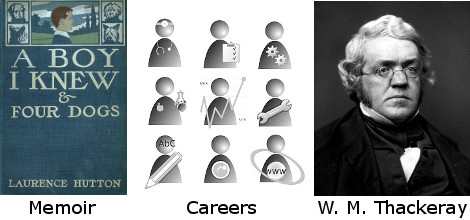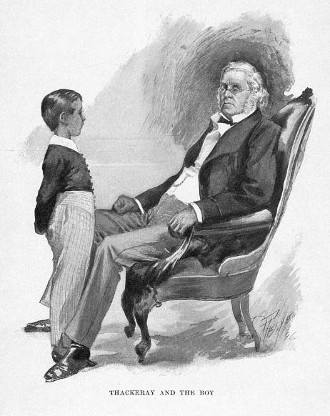Abraham Lincoln? William Makepeace Thackeray? Laurence Hutton? Apocryphal? Anonymous?

Question for Quote Investigator: Selecting a profession can be quite difficult, and changing your initial choice may be necessary. Yet, you should always strive for excellence. The following inspirational words are heartening:
Whatever you are, be a good one.
The phrase is usually attributed to Abraham Lincoln, but it sounds modern to my ear. Books about happiness, coaching, and career choice have all included the saying. Sadly, misattributions to Lincoln are commonplace. What do you think?
Reply from Quote Investigator: QI has found no substantive evidence that Abraham Lincoln made this remark. Lincoln died in 1865, and the earliest attribution to Lincoln was printed in a compendium of quotations in 1946, a very late date.
Interestingly, at the turn of the previous century the saying was firmly attached to another famous individual, the English novelist William Makepeace Thackeray who died in 1863. The earliest instance of the saying located by QI was published in a memoir in 1897 by Laurence Hutton who was a prominent magazine editor, critic, and essayist. The memoir was serialized in “St. Nicholas: An Illustrated Magazine for Young Folks”.
Hutton described a crucial incident from his childhood in the 1850s when he met William Makepeace Thackeray who asked him about his aspirations. Hutton was uncertain about his goals in life, but he replied that he wanted to be a farmer. Thackeray responded to Hutton with a version of the saying which has now become popular. Hutton’s memoir was written in the third person, and he referred to himself as “The Boy”. Boldface has been added to excerpts:1
Mr. Thackeray took The Boy between his knees, and asked his name, and what he intended to be when he grew up. He replied, “A farmer, sir.” Why, he cannot imagine, for he never had the slightest inclination toward a farmer’s life. And then Mr. Thackeray put his gentle hand upon The Boy’s little red head, and said: “Whatever you are, try to be a good one.”
If there is any virtue in the laying-on of hands The Boy can only hope that a little of it has descended upon him. And whatever The Boy is, he has tried, for Thackeray’s sake, “to be a good one!”
By 1904 the above version of the saying was shortened to “Whatever you are, be a good one” and assigned to Thackeray. Both versions were disseminated in the following decades.
QI believes that Laurence Hutton’s memoir was the most likely origin of the statement, and Hutton ascribed the words to William Makepeace Thackeray, but he was writing many years after the incident occurred; hence, uncertainty was inherent. On the other hand, the expression deeply impressed Hutton and influenced his life, so the phrasing he reported might have been accurate.
Here are additional selected citations in chronological order.
The excerpt above was originally printed in the March 1897 issue of “St. Nicholas” and it caught the eye of other magazine editors. For example, the April 1897 issue of “The Bookman: A Literary Journal” reprinted the tale containing the quotation. In the following passage Henry Esmond and Arthur Pendennis referred to characters in novels written by Thackeray:2
And, by the way, Mr. Hutton at the end of the March instalment of that charming bit of autobiography, “A Boy I Knew,” just completed in the St. Nicholas, at last discovers to daylight the whole mainspring of his mundane action. It is all due to Thackeray, and in a sense Mr. Hutton must hereafter be classed with Henry Esmond, Pendennis, and the rest. This is the way he tells the story, and there is a picture of it:
“And then Mr. Thackeray put his gentle hand upon The Boy’s little red head, and said: ‘Whatever you are, try to be a good one.’ “And whatever The Boy is, he has tried, for Thackeray’s sake, ‘to be a good one!'”
Seldom in recorded history has a great man exerted a more powerful influence.
An illustration of the meeting between young Hutton and Thackeray was printed in “St. Nicholas” and that same picture was employed as a frontispiece when Hutton’s memoir was released in book form in 1898 with the title “A Boy I Knew and Four Dogs”.3

In 1904 “The Boston Herald” in Massachusetts reprinted an extended excerpt from Hutton’s memoir in a section devoted to “Books and Book News”. Oddly, the newspaper made some small alterations to the text. Significantly, the statement ascribed to Thackeray was made more concise:4
And then Mr. Thackeray put his gentle hand upon the little boy’s red head and said: “Whatever you are, be a good one.”
In 1908 “The Circle” magazine printed the shortened version of the saying attributed to Thackeray in a section called “Girls’ Own Circle” in an article titled “Some Girls Who Earn Money at Home and What They Say About It”:5
If you have learned that your word is as good as your bond, you have a big asset, and to follow Thackeray’s injunction, “Whatever you are, be a good one,” is a long way on winning success in whatever occupation you have chosen.
In 1910 a magazine published by the Gamma Phi Beta sorority called “The Crescent” printed an instance of the saying attributed to Thackeray:6
In the words of Thackeray to the little boy, “Whatever you are, be a good one.” If you are a college student, be a good one, a good man, a good woman, a good American.
In 1920 the anecdote was presented in capsule form for orators in a periodical called “The Expositor”. The words of Thackeray were slightly altered:7
Lawrence Hutton, in one of his literary reminiscences, says that when he was a sandy-haired boy he once saw the great Thackeray, and the famous English writer put his hand upon the head of this little lad and asked him what he intended to be. At that time he was consumed by an ambition to be farmer and he disclosed this fact to Thackeray; and the great Englishman looked down upon him and said: “Well, my boy, whatever you are, be a good one.” Hutton never forgot that advice.
In 1922 the saying was printed in the business publication “Forbes”, but the words were not credited to a specific person; instead, another magazine was acknowledged:8
Whatever you are, be a good one.
—The Kodak Magazine.
In 1931 a newspaper article about a beauty pageant in Florida included an instance with an anonymous ascription:9
“There is an old saying, ‘Whatever you are, be a good one,’ Whoever Tallahassee sends to Pensacola as a contestant, let’s make her a good one! With so many eligible beauties, it will be a task . . .”
In 1946 a collection of quotations called “Good in Everything: A Treasury of Inspiration, Joy, and Comfort” H. L. Gee included the exhortation with an attribution to the illustrious statesmen Abraham Lincoln; however, no supporting citation was provided. This was the first linkage to the esteemed president found by QI:10
Whatever you are, be a good one.
ABRAHAM LINCOLN
In 1952 a newspaper column reported that a religious figure spoke an instance of the saying to a child:11
Sherry Jackson, 10 year old star of “The Miracle of Our Lady of Fatima,” upon being presented to Cardinal Stritch, hastily confessed: “You know, your eminence, I’m not actually a Catholic.” “That’s all right,” the cardinal replied, “but whatever you are, be a good one.”
In 1982 a book of quotations titled “Good Advice” compiled by “The New York Times” word maven William Safire and his brother included the saying and credited Lincoln:12
Whatever you are, be a good one.
— Abraham Lincoln
In conclusion, QI believes that William Makepeace Thackeray can reasonably be credited with the statement in the 1897 citation. Admittedly, the correctness of this ascription depends on the accuracy of the memory of Laurence Hutton. The connection of the saying to Abraham Lincoln appeared many years after his death and seems to be spurious.
Image Notes: Book cover scan of the 1898 edition of “A Boy I Knew & Four Dogs” Baldwin Library of Historical Children’s Literature at the University of Florida, Gainesville. Job avatars from OpenClips on PixaBay. Daguerreotype photograph of William Makepeace Thackeray by Jesse Harrison Whitehurst via Wikimedia Commons. Frontispiece from the 1898 edition of “A Boy I Knew and Four Dogs”. Images have been cropped and resized.
Acknowledgement: Great thanks to Bodil Isaksen whose query led QI to formulate this question and perform this exploration. Special thanks to John McChesney-Young for obtaining scans of the important 1946 citation.
On January 20, 2025 the format of the bibliographical notes was updated.
- 1897 March, St. Nicholas: An Illustrated Magazine for Young Folks, Conducted by Mary Mapes Dodge, Volume 24, Number 5,A Boy I Knew by Laurence Hutton, (The final installment of a series that began in December), Start Page 409, Quote Page 413, Column 2, Published by The Century Company, New York. (Google Books Full View) link ↩︎
- 1897 April, The Bookman: A Literary Journal, Volume 5, Number 2, Chronicle and Comment, (Short untitled item), Quote Page 92, Column 2, Published by Dodd, Mead and Company, New York. (Google Books Full View) link ↩︎
- 1898, A Boy I Knew and Four Dogs by Laurence Hutton, Quote Page 57, Published by Harper & Brothers, New York. (University of Florida, Baldwin Library of Historical Children’s Literature) link ↩︎
- 1904 July 9, Boston Herald, Books and Book News: Literary Notes, Quote Page 8, Column 8, Boston, Massachusetts. (GenealogyBank) ↩︎
- 1908 January, The Circle, Volume 3, Number 1, Section: Girls’ Own Circle, Some Girls Who Earn Money at Home And What They Say About It, Start Page 63, Quote Page 63, Column 2, Published by Funk & Wagnalls Company, New York. (Google Books Full View) link ↩︎
- 1910 March, The Crescent, A Quarterly Magazine, The Official Organ of Gamma Phi Beta, Volume 10, number 2, College Honor by Lorraine Andrews (Eta 1912), Start Page 111, Quote Page 113, Published by The Sorority: Gamma Phi Beta, Delaware, Ohio. (HathiTrust Full View) link link ↩︎
- 1920 June, The Expositor and Current Anecdotes, The Homiletic Year – June by G. B. F. Hallock, D.D., Sub-Section: Commencement Day, Start Page 887, Quote Page 893, Published by F. M. Barton, Cleveland, Ohio. (Google Books Full View) link ↩︎
- 1922 August 19, Forbes, (Short filler item), Quote Page 483, Column 1, B. C. Forbes Publishing Company, New York. (Google Books Full View) ↩︎
- 1931 August 20, Tampa Morning Tribune, What Tallahassee Girls Are Discarding This Week, Quote Page 4, Column 3, Tampa, Florida. (GenealogyBank) ↩︎
- 1946, Good in Everything: A Treasury of Inspiration, Joy, and Comfort by H. L. Gee (Herbert Leslie Gee), Quote Page 90, Published by Wayne L. McNaughton, Los Angeles, California. (Verified with scans; thanks to John McChesney-Young and the University of California, Berkeley library system) ↩︎
- 1952 September 4, Chicago Tribune, Tower Ticket by Will Leonard, Quote Page B4, Column 6, Chicago, Illinois. (ProQuest) ↩︎
- 1982, Good Advice, Compiled by Leonard Safir and William Safire, Section: Religion, Quote Page 291, Published by NYT Times Books, New York. (Verified on paper) ↩︎